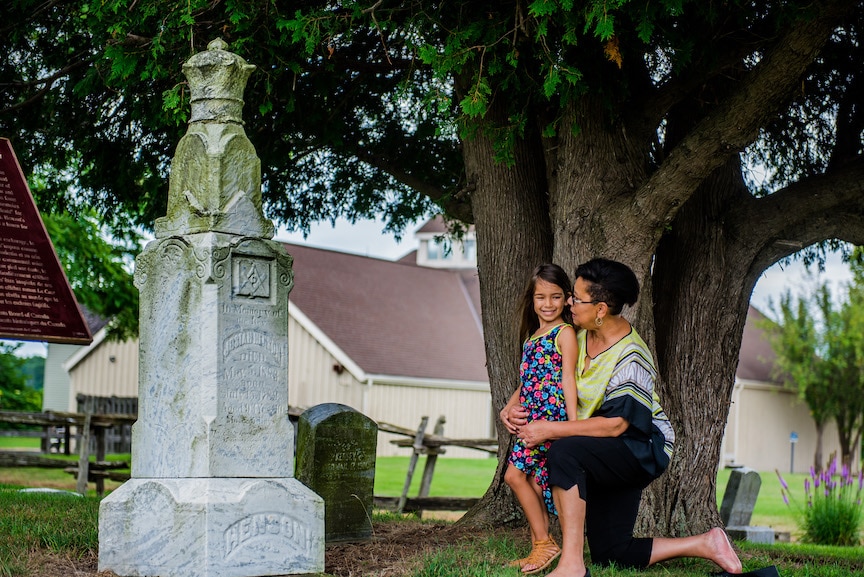
Josiah Henson grave in Dresden, Ontario, topped by a replica of Queen Victoria’s crown. Photo by Dudek Photography courtesy of CK Tourism
By Liz Campbell
Every September, environmentalists and photographers flock to Ontario’s Rondeau Provincial Park for one of nature’s most spectacular displays. For it is here, during the languid days of autumn, that trees turn from green to bright, shimmering orange as thousands of Monarch butterflies alight on leaves and branches. Monarchs gather here to await a favorable wind to help them across Lake Erie on the first stage of their annual migration south to Mexico. In the Spring, monarchs make their way back north. It is one of the world’s largest and most colorful insect migrations.
This is not the only natural migration hosted by this little peninsula that runs along the northern shore of Lake Erie before ending beneath the thumb of Michigan. Because it overlaps both the Mississippi and Atlantic Flyways, Rondeau is an ideal stop-over for 360 species of migrating birds that come north in the spring and return south in the fall.
During the 19th century this part of Ontario became the terminus of another significant migration. This one brought escaping slaves north into Canada, where slavery had been abolished in 1793. They had help along the way from hundreds of men and women who provided food, shelter and guidance. This extraordinary network became known as the Underground Railroad.
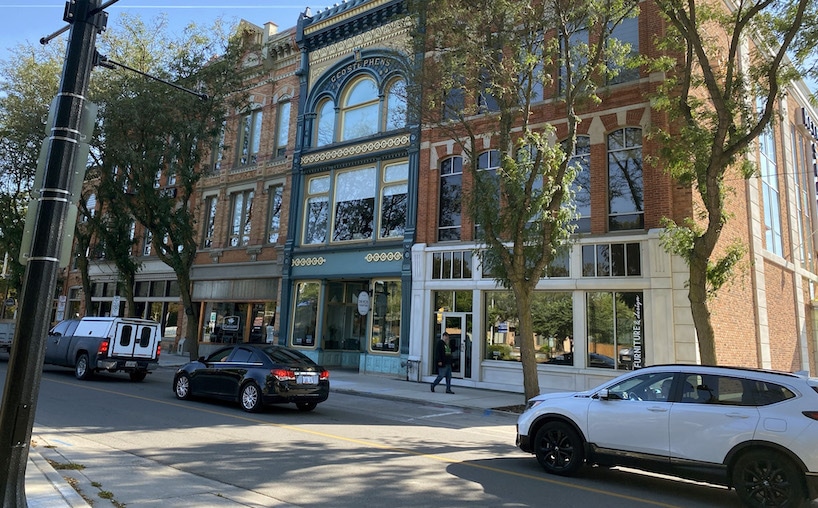
A quiet agricultural town of 102,000, Chatham, Ontario that ranks alongside Alabama’s Civil Rights Trail. Alabama tells the story of the struggle for legal equality and justice. The historic parks, museums and libraries around Chatham reflect a more desperate and dangerous effort by escaped slaves to achieve freedom and dignity. Photo by Liz Campbell
One of the endpoints of this route was Chatham, a pretty Ontario town midway between Lakes Erie and St. Clair. Here time seems to stand still. Victorian and Art Deco buildings line McGregor Creek and the Thames River which merge in the center of town. At their confluence is Tecumseh Park. It plays host to picnickers and RetroFest, one of several classic car festivals that make Chatham a premier destination for car buffs.
While 53 miles away, Detroit builds new cars, Chatham is home to RM Auto Restoration, which restores classic cars, and RM Sotheby’s, one of the world’s largest antique car auction houses. Along with RetroFest, both companies are owned by Rob Myers who designed and built Retro Suites to host the millionaires who come to Chatham to buy old metal. Retro Suites in downtown Chatham rambles through eight heritage-designated, 19th century buildings, their winding corridors filled with remarkable art, memorabilia and antiques.
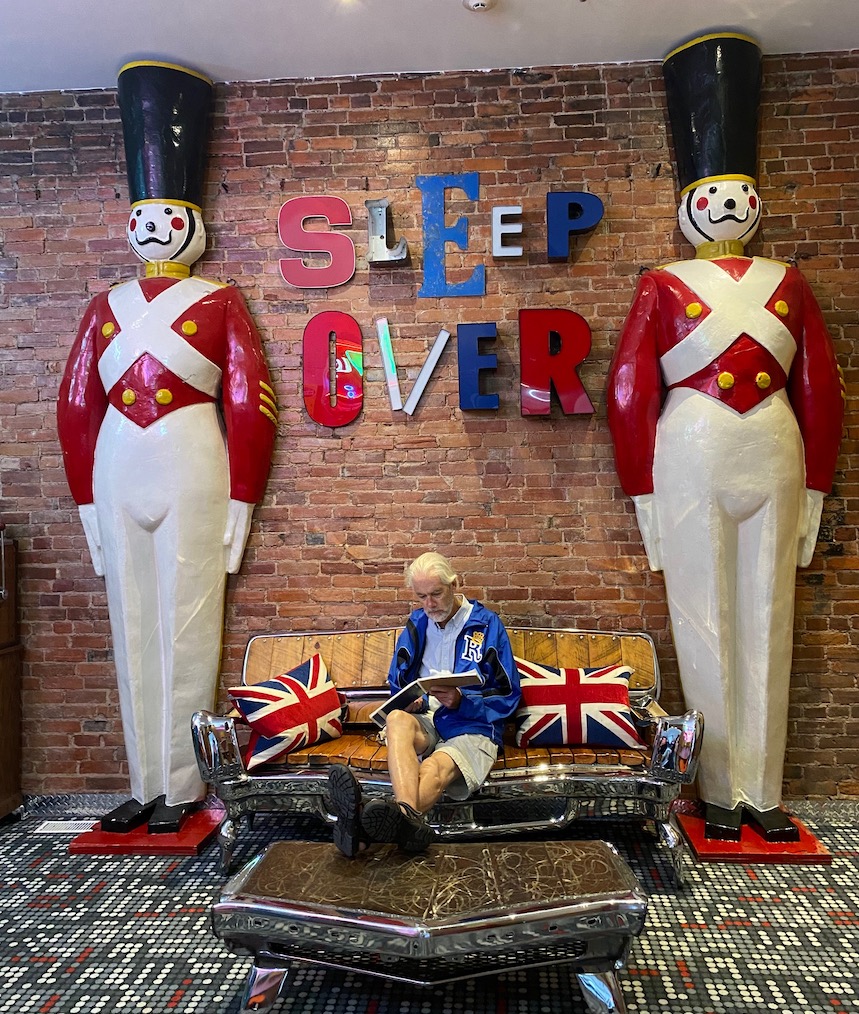
The best place to stay in Chatham is the colorful Retro Suites Hotel, created by the idiosyncratic Rob Myers. Photo by Liz Campbell
Every turn of the halls brings a striking painting, an old Ringling Bros. poster or a piece of art created from dozens of old Matchbox cars. Each of the 45 named rooms is distinctive. The “Easy Rider ” suite has an antique Hudson motorcycle (circa 1900) hanging from the ceiling!
But antique metal tells another, more dramatic story here. Thousands of visitors come each year to several historic sites and museums, where balls and chains, slave collars, and other metal restraints serve to illustrate the experiences of the escapees who came across the Canadian border looking for safety and a new life.
One who sought freedom here was Josiah Henson, a slave who escaped with his wife and four children. Crossing from the USA to Canada in a small boat, Henson made a promise to its captain. “I’ll use my freedom well,” he said.
Born a slave in Maryland, in 1789, Henson took every opportunity to improve his situation, learning to read and write, and eventually becoming a preacher. Years later, in his memoirs, he wrote: “My master and fellow slaves used to look upon me as a wonderfully smart fellow, and prophesy great things. A casual word of this sort would fill me with a pride and ambition which some would think impossible in a Negro slave, degraded, starved, and abused as I was.”
Harriet Beecher Stowe based much of her novel, Uncle Tom’s Cabin, on those memoirs with their poignant descriptions of slave life. Published in 1852, her book sold 3,000 copies on its first day. The book’s graphic depictions of the cruelty of Tom’s life had a profound effect on attitudes toward slavery and helped the abolitionist cause. Indeed, Henson’s story is credited with helping to light the spark that ignited the American Civil War.
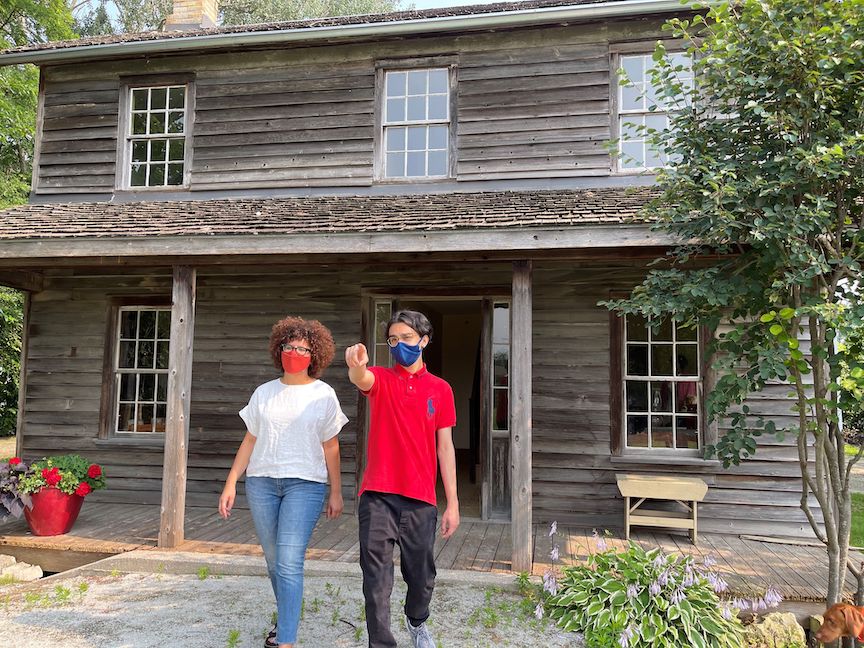
Josiah Henson’s last home, which these visitors are leaving, can be visited along with other 19th century dwellings and research-oriented museums at the Uncle Tom’s Cabin Historic Site maintained by the Ontario Heritage Trust. Photo courtesy of Chatham-Kent Tourism
Henson became a driving force behind the Dawn Settlement, a 200-acre community where both escaped slaves and free Blacks could share their skills, labor and resources. In 1842, he founded the community’s first school in addition to leaving his safe haven to guide 118 other slaves to freedom.
Today, Henson’s last home in Dresden is part of a museum complex called Uncle Tom’s Cabin Historic Site. Located 18 miles north of Chatham, the museum is run by the Ontario Heritage Trust. His small wooden house is part of a complex that includes a museum housing a collection of 19th-century artifacts and rare books pertinent to the abolitionist era.
Henson’s great-great-grand-daughter, Barbara Carter, was the first curator of this museum. Now retired, she acknowledges that Henson’s descendants didn’t know much about their ancestors when she was growing up. “Around my home there was never a lot of talk about the life of Josiah Henson before he came to Canada,” she said. “Generally, blacks who came from slave holders wanted to forget about it.”
Perhaps too, her family wanted to forget the characterization of Uncle Tom that grew from the South’s attempts to disparage the book. “Uncle Tom became a pejorative term with minstrel shows using the name negatively,” says Whitney Belovics, Program Assistant at Uncle Tom’s Cabin Historic Site. “Henson was certainly connected with Uncle Tom, but he advocated for education, built a strong community, and repeatedly put his own life in danger to save others.”
To secure financial assistance for the Dawn Settlement, Henson made trips to the United States and Great Britain, to promote the sale of black walnut wood harvested by the community. He was a guest of Rutherford B. Hayes at the White House. Earlier, in 1851, he was summoned to a personal audience with Queen Victoria. So impressed was the monarch that when Henson died in 1883, she ordered a replica of her crown be placed atop his tombstone in the Dresden graveyard.
If you drive from Dresden to Buxton just southwest of Chatham, stop for a taste of real Southern food at Comfort and Soul. Alecia Durocher’s roots go deep into Tennessee soil and so does her style of cooking. Generous portions of fried chicken and dumplings with biscuits topped with gravy is food that would have been familiar to those who came north in the 19th century.
Buxton was founded in 1849 on land donated by the Canadian government. It was initially led by Rev. William King who freed and added his own 15 inherited slaves to its population. More than 2,000 people of African descent eventually found a home here.
One of the original homes stands on the grounds of the Buxton National Historic Site & Museum. Close scrutiny of the boards shows varying workmanship since each house was a community project. Inside the museum building, old furnishings, sepia photos, and small treasures accumulated by people who were once slaves paint a poignant picture of early life in Buxton.
Outside the museum stands the Liberty Bell. In 1850, the Black citizens of Pittsburgh donated it to the Buxton Academy. The bell called children to school and families to church. Each newly arrived family rang the bell to proclaim their freedom.
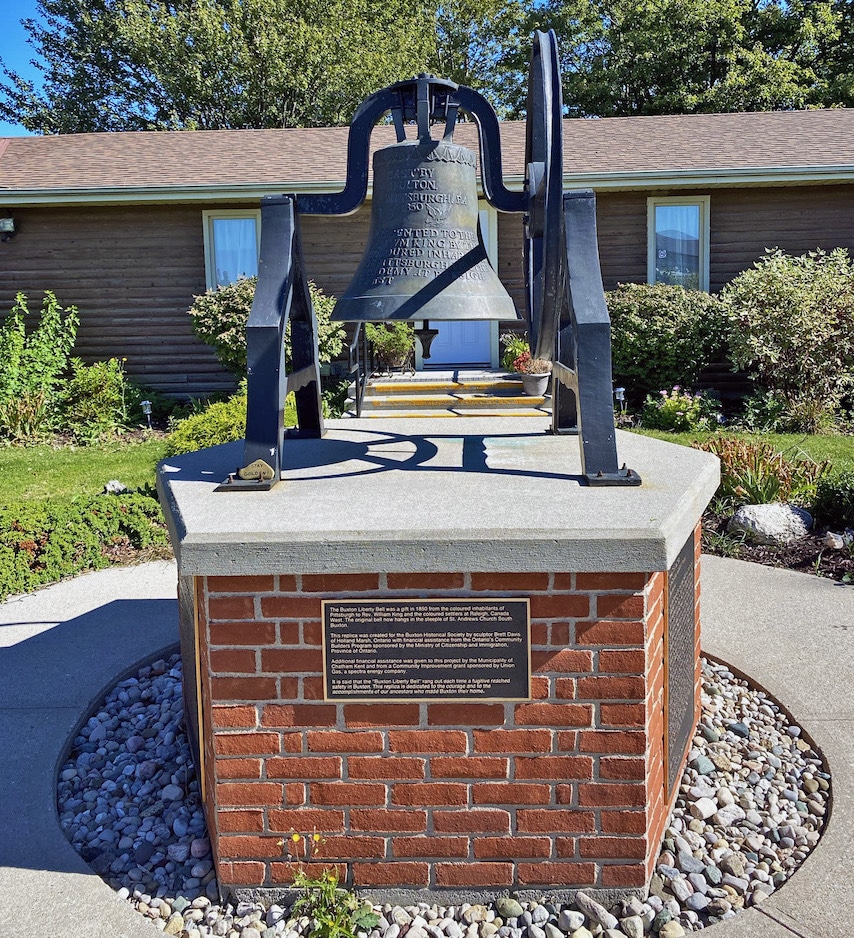
The Buxton Bell would sound every time a new Black family arrived to join the community. Photo by Liz Campbell
The community thrived and in1854 abolitionist leader Frederick Douglass took part in local Emancipation Day celebrations. Afterward, he commented, “I saw men, women and children, who until a short time ago were under the rod of the slave driver, administering for their own good.”
The celebration of Emancipation Day on the first day of August is still a proud annual event that draws people from both sides of the border.
Though slavery was banned in Canada, not everyone welcomed the newcomers. Black children in Buxton were barred from attending the local white school. “So, our community built our own school,” says Shannon Prince, director of the Buxton site, which includes the original school. Her family consisted of some of the first fugitives to settle here. Generations later, she, too, attended the same original school.
“The Buxton Academy provided such an excellent education that white parents started sending their children to it,” Prince adds. “In the end, the Buxton school was full and the other school closed.”
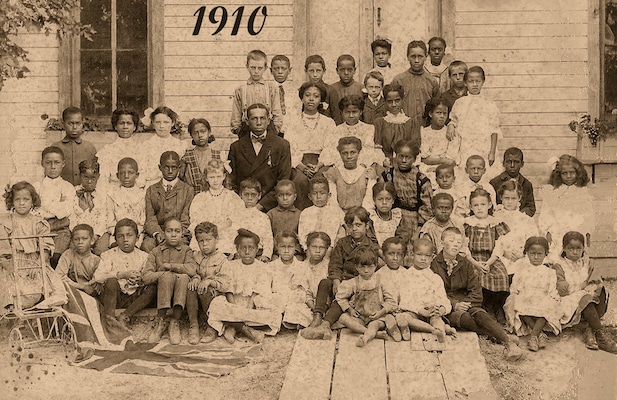
Buxton School Class of 1910
It is significant that although Buxton began as a Black community, the school welcomed everyone. “Black people never segregated themselves or denied anyone access,” says Deirdre McCorkindale, a Chatham native and a Ph.D. candidate at Queen’s University studying the history of racism.
Not all who crossed the border were slaves. Canada was also a destination for many free Blacks. The Fugitive Slave Law of 1850 not only made it illegal to help an escaping slave but also allowed for the capture of any black who was even suspected of having escaped. This sent a flood of new refugees into Canada. Despite being free, Blacks feared they might be rounded up and taken South as escaped slaves.
“In the 1850s, a third of the population of Chatham was black, and included professionals like doctors, businessmen and engineers,” says McCorkindale. “This place was a hotbed of abolitionism. When people came here, they didn’t stop fighting against segregation.”
Abolitionist ideals were taking hold everywhere and Chatham, not far from Detroit and the border, was an important stop for notable figures in the movement. John Brown held a clandestine convention at Chatham’s First Baptist Church in 1859. Only 15 months later he was captured at Harper’s Ferry, and executed as a traitor.
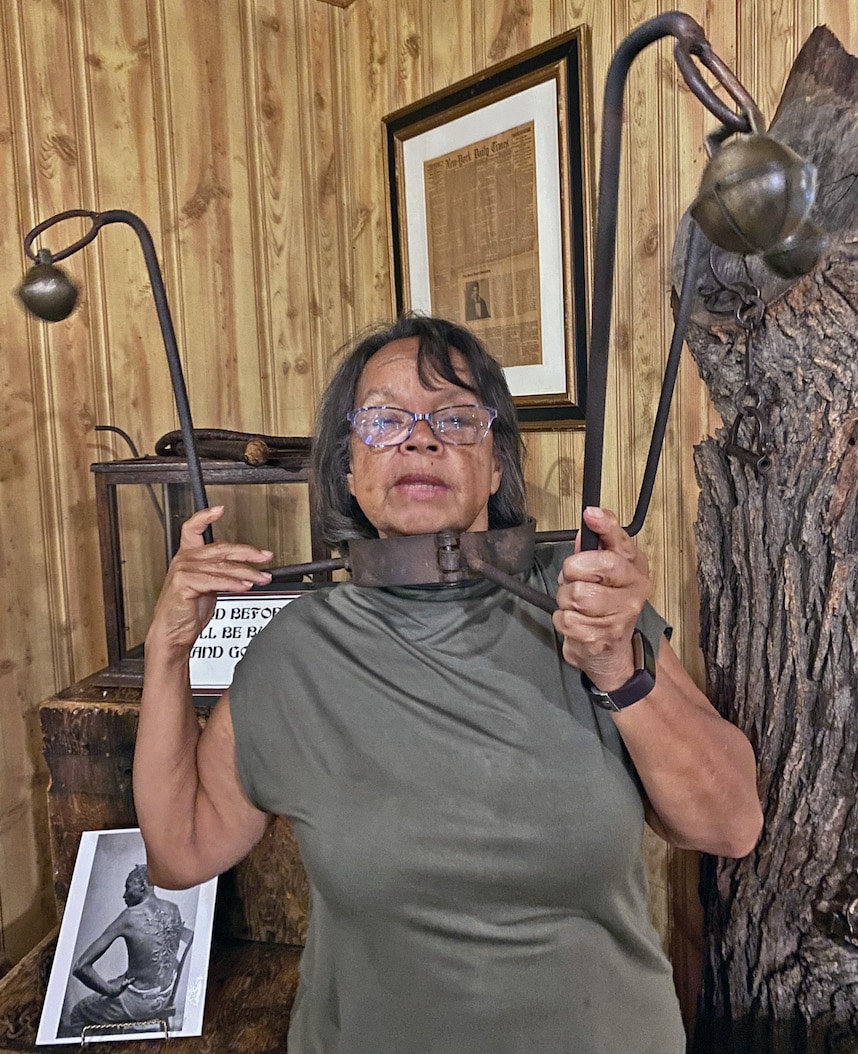
Shannon Prince, Director of the Buxton National Historic Site and Museum, dramatically shows the collar that was put on escaped slaves after they were apprehended. Photo by Liz Campbell
Finding family roots
Mia Brooks grew up in Chatham. Although her father is Black, they had never talked much about their family history. It took a chance remark by a co-worker to start her quest for her family tree. She began tracing her roots and discovered that the bust she had passed so often in Freedom Park was actually that of an ancestor.
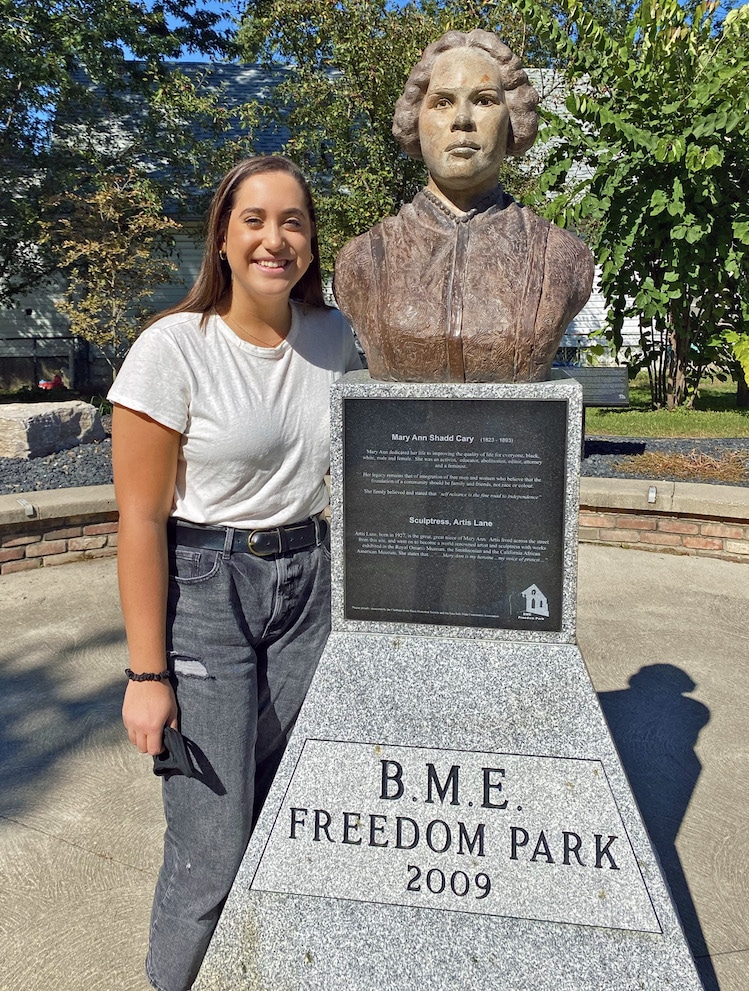
Until she became acquainted with Chatham’s genealogical resources Mis Brooks never realized she was a descendent of Mary Ann Shadd, publisher of The Provincial Freeman, a 1853 weekly newspaper featuring prominent anti-slavery writers. The first Black woman in North America to publish a newspaper, Shadd was designated a Person of National Historic Significance in Canada in 1994. In 2009, her bust was erected in the tiny B.M.E. Freedom Park in Chatham.
She also discovered the first Brooks to cross the border was, in fact, a free man who married an Indigenous woman. As did many of the Black population of Chatham, their children returned to the US to fight in the American Civil War. “It’s been amazing to discover my roots. It’s changed the way I look at history. And I’m so thrilled to find so many new family connections.”
Brooks now volunteers at the Black Mecca Museum, and in October, she took part in the annual Chatham All-Stars baseball game, representing a Brooks ancestor who played with Ontario’s first all-Black organized baseball team.
In 1934, the All-Stars became the first all-Black team to win a Provincial Ontario Baseball Amateur Association (OBAA) championship. Also on that team was the father of Ferguson “Fergie” Jenkins Jr. who was the first Canadian player inducted into the Baseball Hall of Fame. Fergie was born in Chatham; his mother was descended from escaped slaves.
The Chatham-Kent Black Historical Society, part of the Black Mecca Museum, brings people from both sides of the border to research their own family history in documents not available in public records offices. Samantha Meredith, the Executive Director, has made it her mission to organize the files so that their contents might be more easily accessible. Stacks of file folders containing old documents, personal papers and carefully reconstructed family trees sit on the shelves. Digitizing this information is a slow process.
“This resource is so important because research can be difficult,” explains Dorothy Wallace, president of the museum, as well as an enthusiastic volunteer. “Many escaping Blacks hid their backgrounds to protect themselves from recapture and their families from reprisals. Professional slave catchers were paid for every slave they returned – alive or dead – and the border didn’t stop them.”
In these files, Sebastian Jackson has discovered his own roots. “I’m very proud to be a Jackson; it’s a slave name and I’m a descendant of a slave,” he says. “My great grandfather, Harold Jackson, came up from the Southern U.S. with his parents and settled here in Chatham. He became the first Black radio operator licensed in Canada.”
While the earliest descendants of slaves may have been reluctant to share their histories with their children, the current generation remembers the courage of their ancestors, many of whom were leaders in the struggle for emancipation.
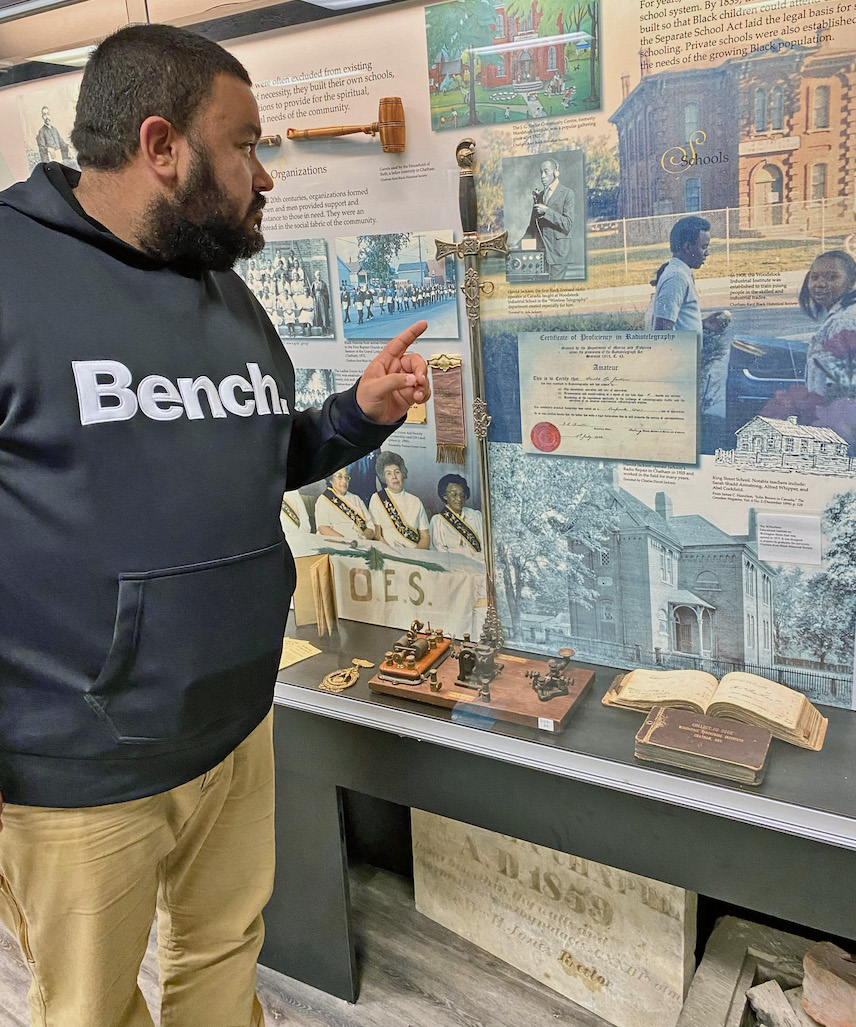
Sebastian Jackson points to a photo of his great-great-grandfather Harold Jackson. Jackson discovered his heritage by doing research in files maintained by the Black Mecca Museum.
“The comfortable story we told ourselves was that the Underground Railroad was the story of brave, white abolitionists and terrified slaves,” says Fergus Bordewich, author of Bound for Canaan – The Underground Railroad and the War for the American Soul. “It’s quite clear that Black Americans often led the cells of the Underground Railroad. It was the first integrated political movement in which African Americans were not only participants but often leaders.”
There are a lot of reasons to visit this area. A bird lover might come hoping to spot a rare Great Kiskadee or Black-bellied Whistling Duck at Rondeau Park. For a classic car buff, RetroFest might offer an opportunity to see some unique classic automobiles.
While here, make an effort to learn about the tens of thousands of people who traveled the railroad that had no rails, a massive migration of Afro American slaves that impacted two countries. Visiting the Underground Railroad museums in the Chatham area shines a bright light on this chapter of North American history with all its horrors and heroism. These days, it’s a chapter worth re-reading lest we forget its message. ![]()
Liz Campbell has been a freelance travel and food writer for more than 20 years. Her recent stories for EWNS include an exploration of fairies in Ireland, the bizarre Yukon outpost of Dawson, the tiny country of Malta, Buffalo, NY. and the lively people of Newfoundland.

